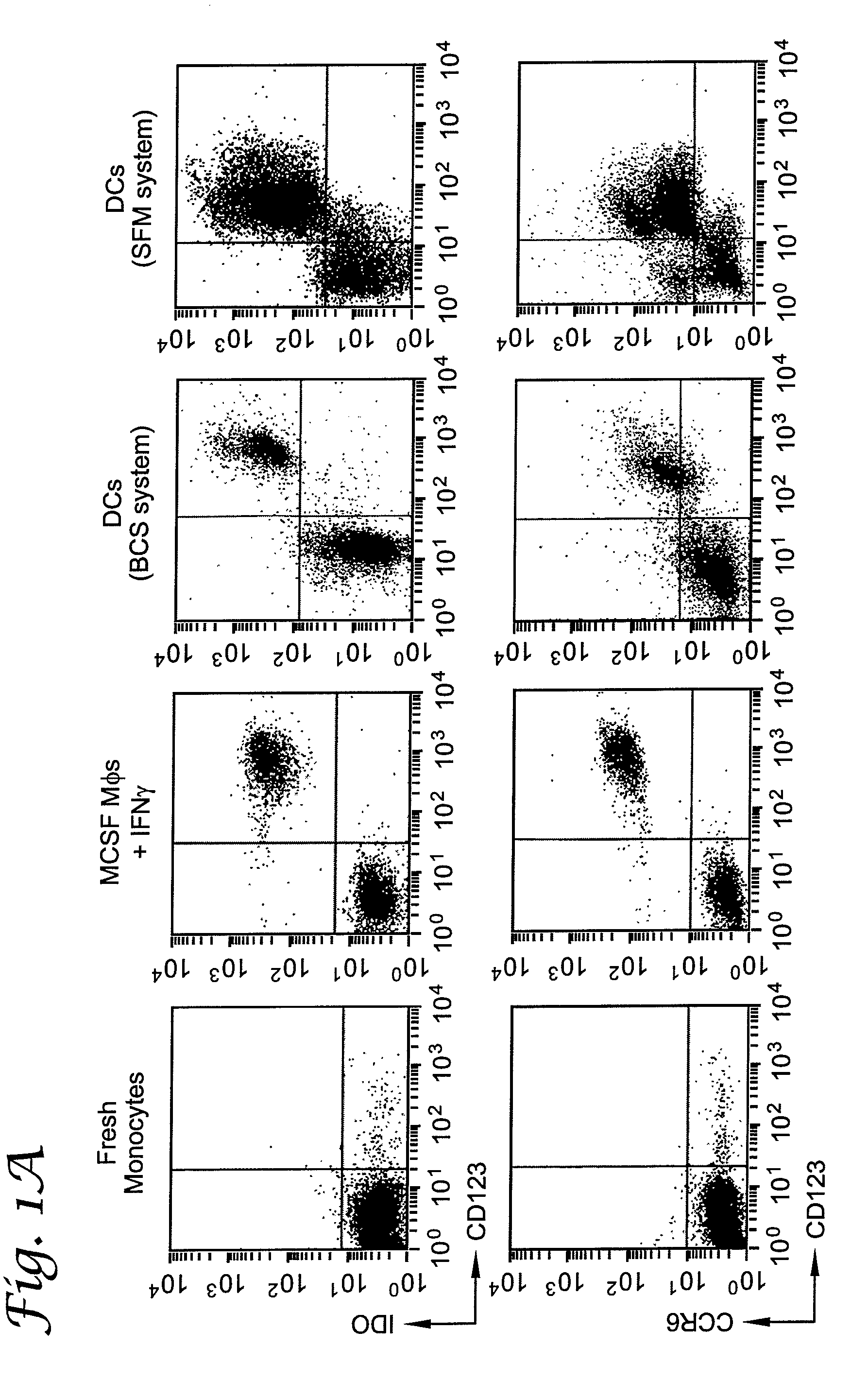Use of Inhibitors of Indoleamine-2,3-Dioxygenase in Combination with Other Therapeutic Modalities
- Summary
- Abstract
- Description
- Claims
- Application Information
AI Technical Summary
Benefits of technology
Problems solved by technology
Method used
Image
Examples
example 1
[0066]Potential Regulatory Function of Human Dendritic Cells Expressing Indoleamine 2,3-Dioxygenase
[0067]This example describes a subset of human APCs that express indoleamine 2,3-dioxygenase (IDO) and inhibit T cell proliferation in vitro. IDO-positive APCs constituted a discrete subset identified by coexpression of the cell-surface markers CD123 and CCR6. In the dendritic cell (DC) lineage, IDO-mediated suppressor activity was present in fully mature as well as immature CD123+ DCs. IDO+ DCs could also be readily detected in vivo, indicating that these cells represent a regulatory subset of APCs in humans.
[0068]Using an IDO-specific antibody (FIG. 3), it was shown by flow cytometry that fresh human monocytes expressed low to undetectable levels of the IDO protein (FIG. 1A). Monocyte-derived macrophages (Mφs) up-regulated IDO upon activation with interferon-γ (IFN-γ) (Munn et al., J. Exp. Med., 1999; 189:1363). Expression of IDO in these cells was confined to a particular subset of ...
example 2
A Small Population of Dendritic Cells in Tumor-Draining Lymph Nodes Mediates Dominant Immunosuppression Via Indoleamine 2,3-Dioxygenase
[0090]The specific role of tolerogenic dendritic cells (DCs) in tumor immunology remains unclear. In part, this is because the specific molecular mechanisms by which DCs create tolerance are still poorly understood (Moser, Immunity, 2003; 19:5). The present example focuses on the immunoregulatory enzyme indoleamine 2,3-dioxygenase (IDO) (Taylor et al., FASEB J., 1991; 5:2516). IDO is a tryptophan-degrading enzyme; its expression by cultured macrophages and DC allows them to inhibit T cell proliferation in vitro (Munn et al., J. Exp. Med., 1999; 189:1363; Hwu et al., J. Immunol., 2000; 164:3596; and Munn et al., Science, 2002; 297: 1867). Transfection of recombinant IDO into tumor cell lines confers the ability to inhibit antigen-specific T cell responses in vitro (Mellor et al., J. Immunol., 2002; 168:3771), and protects immunogenic tumor from reject...
example 3
1-Methyl-[D]-Tryptophan, a Novel, Small-Molecule, Orally-Bioavailable Immune Modulator for Use in Cancer Immunotherapy
[0133]Tumors actively create a state of tolerance toward their own antigens. This pathologic situation allows the tumors to escape from host immune surveillance and also imposes a barrier to effective anti-tumor immunotherapy. One molecular mechanism by which tumors may inhibit immune responses is via the immunosuppressive enzyme indoleamine 2,3-dioxygenase (IDO). IDO degrades the amino acid tryptophan, and this acts to inhibit T cell responses. The small-molecule 1-methyl-D-tryptophan (1MT) acts as an inhibitor of IDO enzyme activity in vitro, and is capable of preventing IDO-mediated immunosuppression in vivo. 1MT thus acts as an immune-enhancing agent in a variety of animal models where IDO limits or suppresses immunologic responses. In this example, administration of 1MT to tumor-bearing hosts in conjunction with low-dose chemotherapy or radiation shows synergist...
PUM
| Property | Measurement | Unit |
|---|---|---|
| Composition | aaaaa | aaaaa |
| Size | aaaaa | aaaaa |
| Therapeutic | aaaaa | aaaaa |
Abstract
Description
Claims
Application Information
 Login to View More
Login to View More - R&D
- Intellectual Property
- Life Sciences
- Materials
- Tech Scout
- Unparalleled Data Quality
- Higher Quality Content
- 60% Fewer Hallucinations
Browse by: Latest US Patents, China's latest patents, Technical Efficacy Thesaurus, Application Domain, Technology Topic, Popular Technical Reports.
© 2025 PatSnap. All rights reserved.Legal|Privacy policy|Modern Slavery Act Transparency Statement|Sitemap|About US| Contact US: help@patsnap.com



